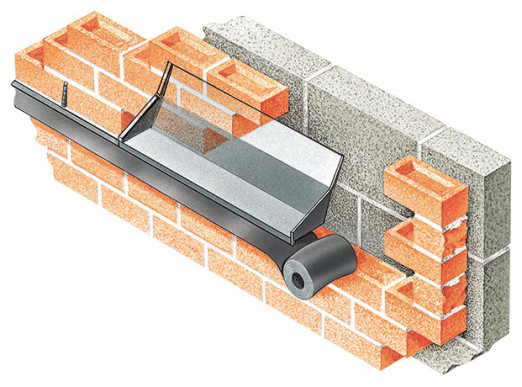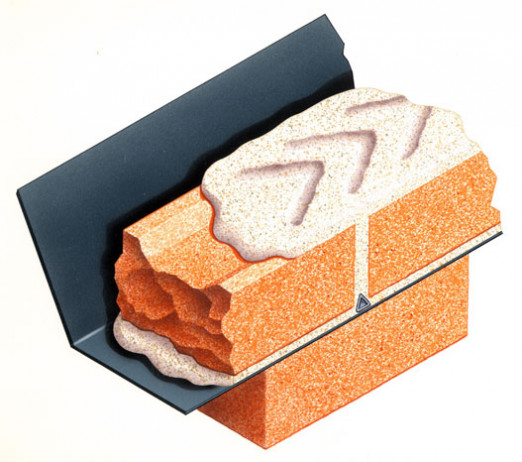Curved cavity walls and spherical corners have in the past posed problems for designers requiring sloping roofs to converge with the shaped masonry, be it concave or convex. Wind-driven rain striking curved masonry will flow diagonally downwards, resulting in increased water volumes transversing across and around the masonry. As well as affecting the extent of localised washing over the surface, curved cavity walls also change the behaviour of water and its permeation of the outer skin.
Sloping roofs abutting curved masonry must take into account the following;
The DPC within the cavity wall and the flashing need to be of a different shape and size at every intersecting course.
Whilst the pitch of the abutting roof may remain constant, the actual angle of intersection changes at every course.
How does one determine the optimum dimensions at each course so every tray integrates with the tray above it in a manner that is watertight and continuous?
How is the upstand in the cavity supported, given that the inner skin is curved and conventional DPC cannot expand to compensate?
What happens within the bedding course where the DPC is required to either elongate or contract as the convex or concave masonry turns – roll DPC cannot do so?
If the inner skin is built in block work, what happens when the nearest course you rely upon to provide support for your DPC is too high or too low?
Externally the flashing is required to act as a waterproof medium to link the wall with the roof tiles. How can one join the flashing and the DPC so the union is watertight
How is wind-driven rain prevented from entering under the flashing leading edge where it is dressed against the masonry?
With the increased amount of water-wash traversing a curved wall compared with that flowing over a straight wall, how does one address this windscreen deflection effect?
Cavity Trays of Yeovil has the solution.
It manufactures preformed individual components, each of which is designed to exactly match the requirements at every intersecting course.
These are called Type X curved Cavitrays and are based on the proven design awarded European Technical Approval.
The advantages of using preformed curved Cavitrays are numerous:
Fabrication on site is eliminated – there is no measuring, no cutting and no wastage.
Preformed also means the shape is already determined – installer mistakes or oversights need not be a consideration.
Each Cavitray has its own adjustable cavity upstand.
There is no requirement to locate and build into an inner skin course as upstands are self-supporting.
Additionally, every tray has an integral end upstand that rises within the masonry at the inboard end to provide a vertical link to the tray above.
Thus, as each tray is laid it integrates with the previously laid tray forming a DPC staircase with connecting treads and connecting risers.
Where trays are supplied with the flashing already attached, the traditional need to rake out joints and introduce flashings separately is eliminated.
The union is pre-established.
Because each Cavitray and flashing overlaps the next Cavitray and flashing, any wind-driven rain that seeps under a dressed flashing leading edge does not come into contact with the masonry under (unlike conventionally cut running flashings).
The Cavitray overlap configuration provides a secondary layer to arrest such water, preventing it from permeating towards and under the adjacent sloping roofline.
Cavity Trays of Yeovil undertakes calculation of all concave and convex abutment requirements / schedules for clients.
Each tray is numbered and boxed.
The mason simply builds in one tray per course as the wall is raised.
Cavity Trays is the only UK cavity tray manufacturer awarded European Technical Approval.
Cavity Trays Ltd of Yeovil
www.cavitytrays.com
enquiries@cavitytrays.co.uk


